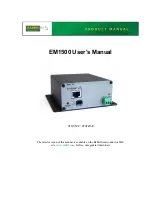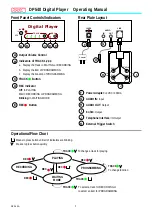
Quick Reference Guide
Instruction Manual: evolution 5000 E5500 Mobile Contribution Encoder
Page G-5
ST.TM.E10033.3
To set up output rates or host encoder
rates use the Host Mux Menu:
1.
From the summary screen press
Menu, Setup, Mux, Host Mux.
2.
From the Host Mux screen press:
a)
On Air - set the multiplexer
output on.
b)
O/P Rate (188) - set the
remultiplexed output bit-rate of
the main MCE multiplexer to 188
byte packets (see Figure 1).
c)
O/P Rate (204) - set the
remultiplexed output bit-rate of
the main MCE multiplexer to 204
byte packets (see Figure 1).
d)
Host Rate (188) - set the bit-
rate of the local (host)
multiplexer to 188 byte packets
(see Figure 1).
e)
Host Rate (204) - set the bit-
rate of the local (host)
multiplexer to 204 byte packets
(see Figure 1).
f)
Scramble (if RAS module fitted)
- set key, either
ON(SNG KEY)
,
OFF
or
ON(FIXED KEY)
, then set
SNG Key Code
to
00000
and
PCR
PID
to
8190
.
g)
Packet Length - set the packet
length to 204 byte packets.
Refer to Figure 4.6: Remultiplexing
Block Diagram in Chapter 4, Equipment
Description.
G.5
Function of the
Remultiplexer
The remultiplexer combines the locally
generated host services with the
externally supplied input services,
connected via ASI to the rear of the
unit. By doing so the multiplexer will
automatically remap PIDs if they clash.
Service names that clash will also be
automatically remapped and time
stamps adjusted if necessary. Refer to
Figure 4.6: Remultiplexing Block
Diagram in Chapter 4, Equipment
Description.
G.6
Rear Panel
Connectors
Figure 1 shows the rear panel
connectors for the unit, with the
remultiplexing option fitted.
Figure 1: Rear Panel Connectors - Unit with
Remultiplexing Option Fitted
G.7
Configurations
The Config Menu allows the user to
store and load the following types of
MCE configuration:
User Defined, User Defined Backup,
Factory 525/625 Default.
16 setup (plus 16 backup)
configurations can be stored.
1.
From the summary screen press
Cfgs.
2.
From the Config Menu select:
a)
Load Active Config – load a
predefined config from memory.
b)
Store Active Config – store the
current config to memory.
c)
Load Cfgs from Backup –
overwrite all existing configs
from backup memory.
d)
Store Config from Backup –
store current configs in backup
memory.
e)
Factory 525/625 Dflts –
restore the factory defaults.
NOTE…
User defined configs can be individually write-
protected using: Write Protect Cfgs.
Remux Option Fitted










































